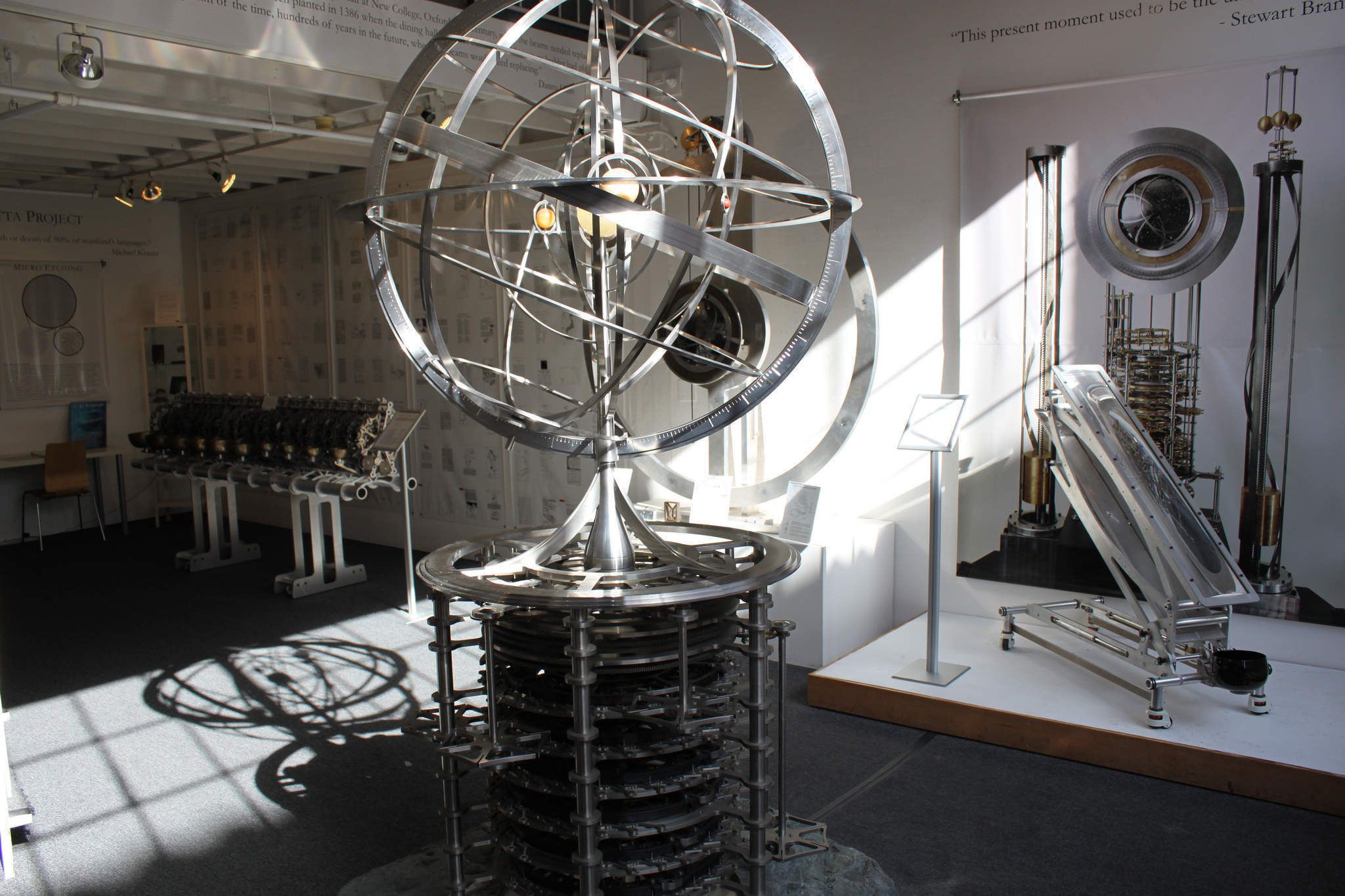
Those with an interest in horology may have come across the Clock of the Long Now.
Despite sounding like something from a fantasy novel, the clock is a real thing. It is, to put it simply, a cuckoo clock. However, instead of the cuckoo popping out of the clock every hour, this clock’s cuckoo only puts in an appearance every millennium.
The Clock of the Long Now is designed to keep time for 10,000 years. Of course, no clock can be relied upon to keep time for 10,000 but it has, at least, been designed to do so. The design principles for the clock are as follows:
-
Longevity: The clock should be accurate even after 10,000 years, and must not contain valuable parts (such as jewels, expensive metals, or special alloys) that might be looted.
-
Maintainability: Future generations should be able to keep the clock working, if necessary, with nothing more advanced than Bronze Age tools and materials.
-
Transparency: The clock should be understandable without stopping or disassembling it; no functionality should be opaque.
-
Evolvability: It should be possible to improve the clock over time.
-
Scalability: To ensure that the final large clock will work properly, smaller prototypes must be built and tested.
The clock will be installed in a remote mountain in West Texas.
However, the most interesting thing about the clock is its price tag. The full cost of the Clock of the Long Now is expected to be around $42 million. The project is being bankrolled by Jeff Bezos, the founder of Amazon.
And while Bezos is more than entitled to do whatever he chooses with his money, the big question is: why?
Aside from serving the symbolic purpose of encouraging all of us to think about the long term consequences of our actions, the clock doesn’t really do much. It’s literally just a big clock. Which is cool, but is it really worth $42 million? Really?
Perhaps the reason for Bezos’ interest in the project was summed up by founding board member of the Long Now Foundation, Stewart Brand:
Such a clock, if sufficiently impressive and well-engineered, would embody deep time for people. It should be charismatic to visit, interesting to think about, and famous enough to become iconic in the public discourse.
Ideally, it would do for thinking about time what the photographs of Earth from space have done for thinking about the environment. Such icons reframe the way people think.
What better way to leave a lasting legacy on Earth than with a pointless piece of paraphernalia which people will come to visit 10,000 years after you’ve died? It’s a strategy that worked for the ancient Egyptians and their pyramids. Why couldn’t it work for Amazon’s Jeff Bezos?
Still, even if the Clock of the Long Now is a pointless vanity project for Jeff Bezos, he’s hardly the first billionaire to pump his millions into such a venture.
Other vanity projects from millionaires:
Robert Klark Graham – Repository For Germinal Choice
Klark Graham made his money by inventing plastic shatterproof lenses. Very helpful for glasses-wearers.
Of course, the other thing that Klark Graham took a casual interest in was eugenics. That’s right, folks, the practice of trying to improve the genetic quality of the human race. Another famous proponent of the idea was Adolf Hitler who expressed enthusiasm for eugenics in Mein Kampf.
To this end, Klark Graham ended up creating the Repository For Germinal Choice which was, in essence, a fancy sperm bank. Herein, he planned to collect sperm samples from Nobel Laureate winners to ensure that any children born from samples given by to the lab would be geniuses.
Eventually, Klark Graham had to relax his standards in order to actually get samples. He eventually downgraded those who could donate to anyone married and with a high IQ. Following further slow uptake of his idea, he included those who were athletic champions in his bank.
Women who accepted sperm from the respository were not screened for intelligence. Any healthy woman who was in good health, not homosexual, and married were accepted. Only two women were ever reported to be denied: one [woman] who took lithium, [and] another who was obese and diabetic.”
Only 219 children were conceived from sperm samples taken from the repository.
In a series of articles on Slate in 2001, journalist David Plotz caught up with 20 of the children allegedly conceived through the sperm bank’s samples. He reported that many of them shared their biological parents’ high IQ but were not supernaturally intelligent. He also concluded that many of the children were brought up in conditions that any child would have thrived in, so their intelligence isn’t necessarily down to the sperm from which they were conceived.
After Klark Graham died, the repository closed.
Elon Musk – Tesla in space
The most recent item on this list is Elon Musk’s infamous Tesla in space. The billionaire businessman launched his own Tesla Roadster into outer space aboard SpaceX’s Falcon Heavy rocket.
The move was a remarkable bit of brand synergy for for Musk, who owns both Tesla and SpaceX. But what did it really accomplish? Well, not a lot. Sure, there was a car in space; cool, so what? So nothing. Speaking to reporters ahead of the launch in February 2018, Musk explained:
[The roadster] will get about 400m km away from Earth and it’ll be doing 11km/s. We estimate it will be in the orbit for several hundred million years, maybe in excess of a billion years.I’ll consider it a win if it just clears the pad and doesn’t blow the pad to smithereens. That’s 4m pounds of TNT equivalent. There’s probably not going to be much left if that thing lets loose.
In total, the launch cost Musk $90 million. That seems a lot, but it’s actually relatively cheap for space travel. And with or without the Tesla attached, it’s a win for Musk who plans to use SpaceX rockets like the Falcon Heavy to one day colonise Mars.
But ultimately, Musk could have shot anything into space. Using a Tesla for the launch is nothing more than a vanity project designed to ensure a piece of Musk’s legacy will live on for maybe in excess of a billion years, according to some predictions.
Clive Palmer – Palmersaurus and Titanic II
One of the most interesting names on this list, Clive Palmer owns Mineralogy, Waratah Coal, Queensland Nickel, a series of mining companies in Australia. He’s also a poet and politician, a conspiracy theorist and an expert with memes.
— Clive Palmer (@CliveFPalmer) March 4, 2018
Safe to say, Palmer definitely qualifies as an eccentric billionaire.
However, there are two of Palmer’s vanity projects that have proved more delightful than any other.
The first is that he is bankrolling the construction of the ‘Titanic II’. However, as of 2018, construction of the Titanic II has not begun and the Blue Star Line company’s trademark has elapsed. The last official update on the project was made in 2014.
Secondly, is Palmer’s attempt to become a real-life John Hammond from Jurassic Park. According to various Australian media outlets, Palmer had been in touch with the scientists who cloned Dolly the sheep, offering to bankroll them as they attempted to clone a dinosaur.
However, his fascination with sauropods did continue. After installing a ten metre tall T-Rex named Jeff in the middle of the golf course at his Coolum resort, Palmer opened Palmersaurus. This was the world’s biggest dinosaur park, with over 160 animatronic attractions. However, it did not prove popular.
Tickets to Palmersaurus cost 100 Australian dollars per family, which many considered too expensive. Palmer justified the cost by saying it was cheaper than a trip to Disneyland.
In addition, after Palmer announced the dinosaur park at the golf course, the Australian PGA Tour did not renew its 11-year stop at the course. By August 2014, most of the staff had been laid off at the resort. By the end of 2015, the whole resort was closed.
Clive Palmer’s current vanity projects have so far been a total disaster. But he’s still making memes, so that’s something…
Oi oi oi pic.twitter.com/htMdr6ukrV
— Clive Palmer (@CliveFPalmer) March 7, 2018
Paris Hilton – Dog mansion
Not so much a vanity project as just a bizarre use of money. Hilton is famous for many reasons, among them her love of dogs. The socialite almost single-handedly popularized the chihuahua breed through her relationship with her own dog, Tinkerbell, who was almost constantly spotted in the star’s handbag.
In order to pay reverence to her animal besties, Hilton constructed a two-storey mansion for her dogs. The house has a tile roof and wrought iron railings on its upstairs balcony. Inside, the walls all coated in pink (Hilton’s favourite colour.) There’s an air conditioning unit, various fancy dog beds, and even a chandelier.
Here is Hilton standing outside the dog mansion:
Henry Ford – Greenfield Village
Almost everyone in the world knows of Henry Ford. The billionaire was among the first of the industrialists to popularise assembly line production, doing so to create affordable family motorcars that average Americans could afford.
However, what’s less well know about Ford is that he was really into history. Ford used a good chunk of his fortune to Henry Ford Museum of American Innovation, sometimes known as Greenfield Village.
The museum is the largest indoor-outdoor museum in America and houses all kinds of attractions including JFK’s limousine, the bus in which Rosa Parks began her famous civil rights protest, and Abraham Lincoln’s chair from Ford’s Theatre, and even the first ever 1965 Mustang.
But what’s even more interesting is the outdoor part of the museum. Here, Ford bought full historical buildings and had them transplanted piece by piece into Greenfield, Michigan. Visitors can go and see the Wright Brothers house (transplanted from Dayton, Ohio), Thomas Edison’s laboratory (transplanted from New Jersey), the oldest mill in America (transplanted from Massachusetts), and Henry Ford’s childhood home. The attraction is a living museum with re-enactors demonstrating how life was lived from the turn of the 20th Century.
As a vanity project, it’s certainly one of the less-offensive ones out there. The museum has proved popular with Americans, receiving around 1.6 million visitors a year.
Bidzina Ivanishvili – Personal forest
Everyone needs a hobby, right? Bidzina Ivanishvili’s hobby is trees. The billionaire former prime minister of Georgia has rare and ancient trees ripped out of the ground, transported to his personal arboretum, then replanted there. As a result of having done so far years, Ivanishvili has whole private forest on his hands.
The billionaire now lives in a compound just outside of the Georgian capital of Tbilisi, surrounded by his personal forest. Therein he has his own private zoo with zebras, penguins, parrots, kangaroos, lemurs flamingos, and, in a truly James Bond-villain-style flourish, a shark tank.
In addition, the village in which his vast mansion is located is often showered with gifts. Speaking to the Observer, Ivanishvili said:
£80 cash gift every month, and a £1,200 gift if they get married — with the wedding itself paid for — and can have their houses renovated, or rebuilt from scratch, complete with white goods and furniture, for nothing.
The same article reports that he also donates $10 million to charity every month.
Aside from these trappings of wealth though, Ivanishvili says he does not care for luxury. However, he has hinted at a vanity project of his own, saying he wants to build a privately owned art gallery in his own name.







